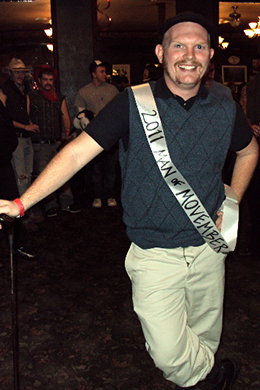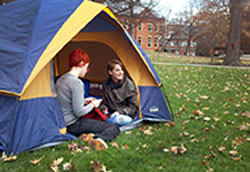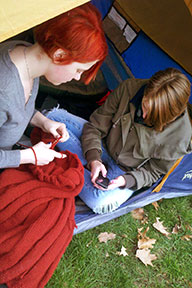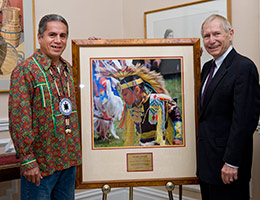 Imagine millions of grains of sand from Indiana, Pa., traveling throughout the world, with the mission of creating compassion wherever the streams, rivers, and oceans take them.
Imagine millions of grains of sand from Indiana, Pa., traveling throughout the world, with the mission of creating compassion wherever the streams, rivers, and oceans take them.
Stuart Chandler, a professor of Religious Studies and chairperson of the department, is responsible for the visit this week of ten Buddhist monks from the Drepung Loseling Monastery. The monks are creating a mandala of compassion in the Hadley Union Building. It’s fascinating to watch, and visitors also get a chance to build a community sand art project, using the same tools used by the monks.
And just in case you think it’s simple, or casual, think about this. The monks go through two years of training, memorizing hundreds of mandala designs, and must be chosen for this work. I wish I had a better word than “work”; it is not work in the way that we think of the term in America–it’s a way of life. Dr. Chandler told me that the head monk was born in Tibet and smuggled out of the country as a child, becoming a monk at the age of five. He never saw his family again. The monks all have a special role to play: some chant, some dance, some are the mandala creators.
I strongly encourage you to visit the program. During the mandala creation, the monks are silent unto themselves (for the seven hours per day that they work). They are in the HUB working from 11:00 a.m. to 6:00 p.m. today, Thursday, and Friday; from 9:00 a.m. to 4:00 p.m. Saturday; and from noon to 5:00 p.m. Sunday.
But if you can’t get to the HUB, you can still be part of the project. There is a live webcam capturing the work being done on the mandala. The intensity of their concentration is evident, even over the Internet. (We are showing the live webcam on this entry, too. Refresh to update the picture.)
On Monday, the mandala will be completed–just for an hour, from 11:30 a.m. to 12:30 p.m.–and then will be swept up, with bags of sand being distributed to visitors. The rest of the sand will be carried in a vase by the monks down Philadelphia Street and put into a stream, to find its way into the ocean.
“It’s about filling the world with compassion,” Dr. Chandler explains.
The monks travel for two years and then return to the monastery in India. They have been to many colleges and universities throughout the United States and have been at the Smithsonian. IUP hosted the monks for a mandala construction in 2003 and 2006. These appearances also were arranged by Dr. Chandler, who has been at IUP since 2000. His area of concentration is the religions of China and Japan, especially Buddhism, and he has also conducted research closer to home. His “Eastern Religions Come to Western Pennsylvania” exhibition in 2005 at the University Museum reflected his study on the evolving religious landscape of Pennsylvania. His current project is the translation of the memoirs of Oishi Junkyo, a geisha, artist, and Buddhist nun in early twentieth century Japan.
When I think of the term “renaissance man,” Dr. Chandler comes to mind. In addition to his “day job,” in summer 2006, he bicycled 2,000 miles across the northern United States and Canada with his son Evan, and he also is a musician in the Indiana-famous Dad Band.
On Saturday evening, the monks will be at the Performing Arts Center’s Fisher Auditorium as part of the Lively Arts programming. “The Mystical Arts of Tibet: Sacred Song Sacred Dance” is a mixture of traditional dances, Tibetan multiphonic chanting, and other music to channel inner spirituality and enlightenment.
A pretty amazing week at IUP.
 IUP’s Greek fraternities raised $1,500 for the national Movember project, which promotes awareness of men’s health issues, especially prostate and testicular cancers.
IUP’s Greek fraternities raised $1,500 for the national Movember project, which promotes awareness of men’s health issues, especially prostate and testicular cancers.
 Students in Robert Sweeny’s art class are REALLY putting themselves out there.
Students in Robert Sweeny’s art class are REALLY putting themselves out there. Other students in the group are in the tent doing things that they do in their personal lives. Manno is knitting, Keebaugh is texting, and other students will be “on display” later today.
Other students in the group are in the tent doing things that they do in their personal lives. Manno is knitting, Keebaugh is texting, and other students will be “on display” later today.
 IUP works to honor and remember those who lost their lives in service to our country. The memorials on campus recognizing our veterans were the subject of a special
IUP works to honor and remember those who lost their lives in service to our country. The memorials on campus recognizing our veterans were the subject of a special  It’s fun to mentally compare the strengths and weaknesses of both monsters, as was done at the recent
It’s fun to mentally compare the strengths and weaknesses of both monsters, as was done at the recent  When vampires and zombies wage war, or when any catastrophe occurs, humanity will feel the results. In the end, it doesn’t matter which of the monsters win. It’s all about how we handle the situation and what we do to save ourselves.
When vampires and zombies wage war, or when any catastrophe occurs, humanity will feel the results. In the end, it doesn’t matter which of the monsters win. It’s all about how we handle the situation and what we do to save ourselves. It’s going to get a little hairy around campus this month.
It’s going to get a little hairy around campus this month. There’s a beautiful photograph in the president’s office at IUP, taken by retired Communications Media professor Richard Lamberski.
There’s a beautiful photograph in the president’s office at IUP, taken by retired Communications Media professor Richard Lamberski. I was delighted to receive this photo from Theresa McDevitt, a
I was delighted to receive this photo from Theresa McDevitt, a